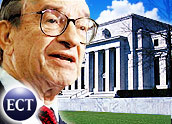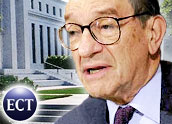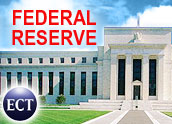
The Federal Reserve raised short-term interest rates by a quarter point, to 1.5 percent, on Tuesday afternoon. That much was widely expected. The real news lay in the accompanying statement, in which the Fed strongly implied that it would continue to raise rates in coming months.
Although the report acknowledged that recent economic news indicates slowing job growth and productivity, it claimed that the economy “nevertheless appears poised to resume a stronger pace of expansion.”
Interest rate hikes often prompt stock sell-offs, but the markets initially reacted to the Fed statement with enthusiasm. Standard & Poor’s, Dow Jones and Nasdaq all showed gains Tuesday.
By Wednesday morning, however, investors appeared to have second thoughts. In morning trading, all three indexes were down. High oil prices, inflation, slow growth and the threat of terrorism appear to be weighing on investors, despite the Fed’s reassurances yesterday.
Inflation and Jobs
In the statement, members of the Federal Open Market Committee downplayed worries about the recent economic slowdown and shifted attention to inflation. The Fed has a dual mandate — to keep both inflation and unemployment in check. Raising interest rates can slow the rate of inflation, but it can also limit job growth.
After a bleak job report released by the Department of Labor on Friday, many economists expected that the Fed would raise rates this month and then delay further increases until after the November presidential election.
Given the concern about inflation expressed in yesterday’s report, most economists now expect the Fed to raise the benchmark rate to 1.75 percent at its next meeting, on September 21, and continue rate hikes for the rest of the year.
Much Depends on Oil
According to the report, the slow pace of economic growth and job creation should be attributed to “the substantial rise in energy prices” and not taken as a sign that the economy is headed for trouble. The Fed expects strong growth for the rest of the year.
The new report was consistent with Chairman Alan Greenspan’s statement last month, when he said that the current “soft patch” in the economy would be prelude to quicker growth.
The accuracy of the Fed’s prediction will depend heavily on oil prices, which have increased more than 30 percent since the start of the year and now stand above US$44. The Fed’s rosy outlook relies on its expectations that oil prices will moderate. If they don’t, the economic outlook might sour.
The Fed’s Statement
What follows is the complete text of the Fed statement:
The Federal Open Market Committee decided today to raise its target for the federal funds rate by 25 basis points to 1-1/2 percent.
The Committee believes that, even after this action, the stance of monetary policy remains accommodative and, coupled with robust underlying growth in productivity, is providing ongoing support to economic activity. In recent months, output growth has moderated and the pace of improvement in labor market conditions has slowed. This softness likely owes importantly to the substantial rise in energy prices. The economy nevertheless appears poised to resume a stronger pace of expansion going forward. Inflation has been somewhat elevated this year, though a portion of the rise in prices seems to reflect transitory factors.
The Committee perceives the upside and downside risks to the attainment of both sustainable growth and price stability for the next few quarters are roughly equal. With underlying inflation still expected to be relatively low, the Committee believes that policy accommodation can be removed at a pace that is likely to be measured. Nonetheless, the Committee will respond to changes in economic prospects as needed to fulfill its obligation to maintain price stability.
Voting for the FOMC monetary policy action were: Alan Greenspan, Chairman; Timothy F. Geithner, Vice Chairman; Ben S. Bernanke; Susan S. Bies; Roger W. Ferguson, Jr.; Edward M. Gramlich; Thomas M. Hoenig; Donald L. Kohn; Cathy E. Minehan; Mark W. Olson; Sandra Pianalto; and William Poole.
In a related action, the Board of Governors unanimously approved a 25 basis point increase in the discount rate to 2-1/2 percent. In taking this action, the Board approved the requests submitted by the Boards of Directors of the Federal Reserve Banks of Boston, New York, Philadelphia, Cleveland, Richmond, Atlanta, Chicago, St. Louis, Minneapolis, Kansas City, Dallas, and San Francisco.














































Social Media
See all Social Media